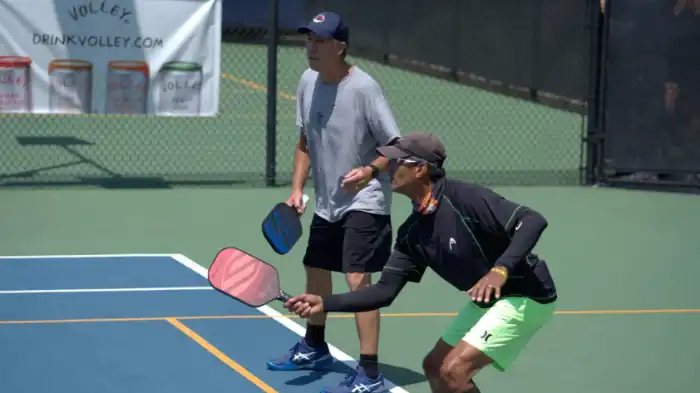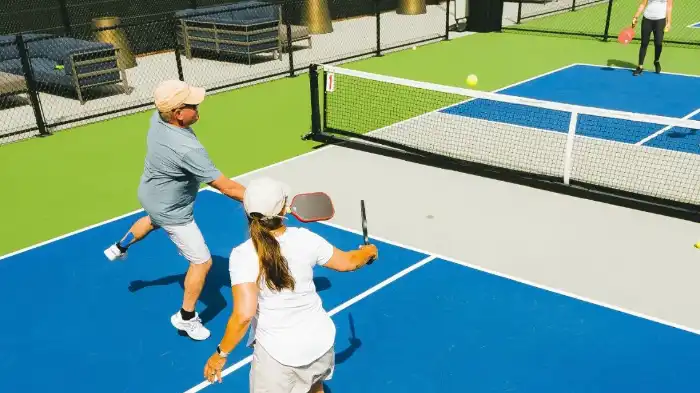Pickleball is a fast-growing sport that combines elements of tennis, badminton, and ping pong. It can be played in singles or doubles, with doubles being the most popular format. While pickleball is known for its simplicity, there are advanced strategies that can greatly enhance your game. In this blog post, we will explore the Advanced Pickleball Strategy Doubles specifically tailored for doubles play.
The Importance of Communication
Effective communication is crucial in Advanced Pickleball Strategy Doubles. It allows partners to coordinate their movements, make split-second decisions, and ultimately outmaneuver their opponents. Having a clear communication system in place can significantly improve your chances of winning.

One popular communication strategy is using hand signals. For example, a player can tap their paddle twice to signal a switch in court position, or raise their paddle to indicate they are going to take a shot. By implementing these signals, partners can anticipate each other’s moves and act accordingly.
The Role of the Server
In Advanced Pickleball Strategy Doubles, the server has a significant role in setting the tone for the game. A well-executed serve can put pressure on the opposing team right from the start. One effective strategy is the “Split Serve,” where the server aims for the middle of the opponent’s court, creating confusion and increasing the chances of a weak return.
Another tactic is the “Power Serve,” where the server delivers a hard, low serve that makes it difficult for the opponent to return. This can force the receiving team to hit a high ball, allowing the serving team to take control of the point.
Effective Court Positioning
Court positioning is a crucial aspect of pickleball strategy. In doubles play, it is important to maintain an optimal court position that maximizes your chances of covering all areas of the court while minimizing vulnerabilities.
The ideal court position for the serving team is to have one player at the baseline near the centerline and the other player at the non-volley zone (also known as the “kitchen”) line. This positioning allows the serving team to cover both the deep shots and the short drops better.
When the receiving team is returning the serve, they should adopt a slightly different court position. One player stands near the middle of the baseline, while the other player positions themselves at the non-volley zone line, ready for a quick volley or a putaway shot.
Mastering the Third Shot Drop
The third shot drop is a fundamental technique in doubles pickleball that allows the serving team to regain control of the point. It involves hitting a soft, downward shot that clears the net and lands in the non-volley zone, making it difficult for the opponents to attack.

A successful third shot drop requires precise technique and strategic placement. The shot should have enough height to clear the net and allow time for the serving team to get into a strong defensive position. Aim to land the ball close to the opponent’s baseline, forcing them to hit a deep return and giving you time to move forward and assume a dominant position at the non-volley zone line.
Conclusion
Mastering Advanced Pickleball Strategy Doubles can elevate your game to a new level. Effective communication, strategic court positioning, and well-executed serves and shots can give you a significant advantage over your opponents. By incorporating these advanced strategies into your gameplay, you’ll increase your chances of winning more points and ultimately dominating the doubles pickleball court.
Frequently Asked Questions
The most crucial strategy in doubles is effective communication and coordination with your partner. Constantly communicating about positioning, shot selection, and court coverage will greatly enhance your chances of winning.
When deciding on a shot, it is essential to consider the positioning of both yourself and your opponents. Aim to hit shots away from your opponents, forcing them to scramble and potentially make errors. Additionally, mixing up your shot selection, including lobs, dinks, and aggressive drives, will keep your opponents off balance.
To avoid getting stuck in a defensive position, focus on maintaining a strong and aggressive position at the kitchen line. This will allow you to take control of the game and put pressure on your opponents. Additionally, playing smart, low-risk shots instead of attempting risky shots will minimize your chances of being forced into a defensive position.
Practice and communication are key to improving teamwork and coordination with your partner. Regularly playing together and discussing strategies off the court will help develop a better understanding of each other’s playing styles and tendencies. You can also drill specific scenarios to enhance your coordination in real game situations.
When facing powerful smashes, an effective defensive strategy is to practice good positioning and solid footwork. Try to anticipate your opponent’s shots and quickly move into position to intercept and return the ball. Additionally, utilizing a soft block or a controlled lob as a defensive shot can help neutralize the power from your opponents’ smashes.

